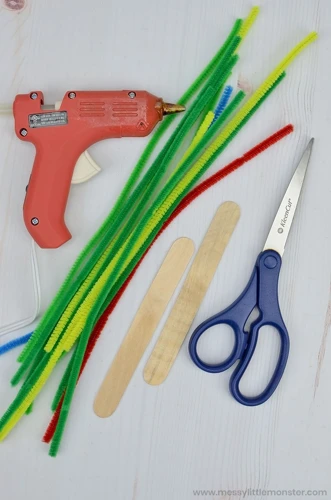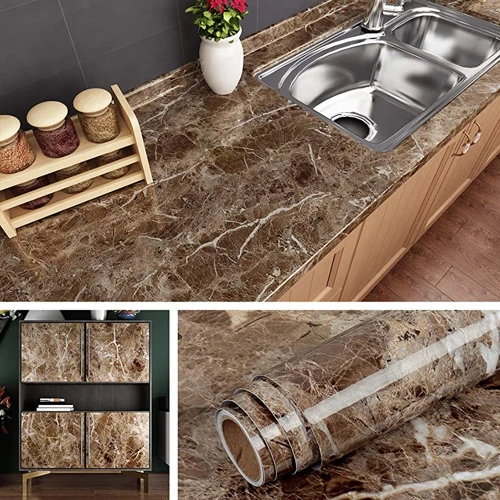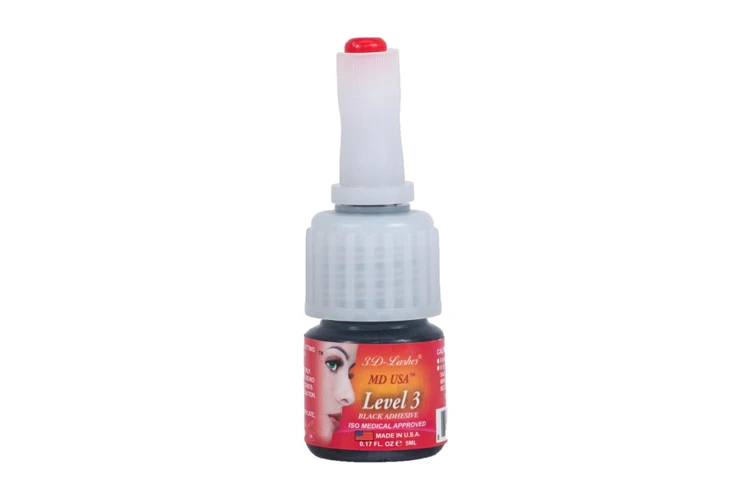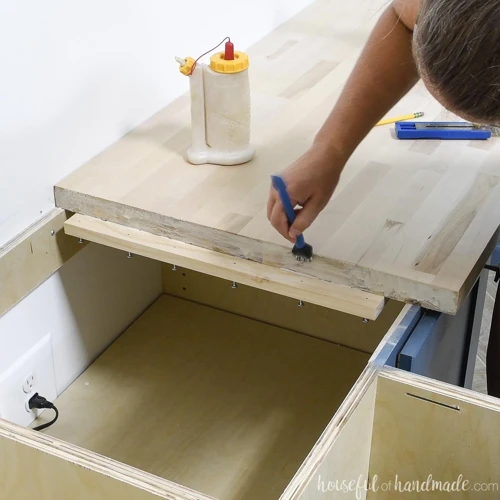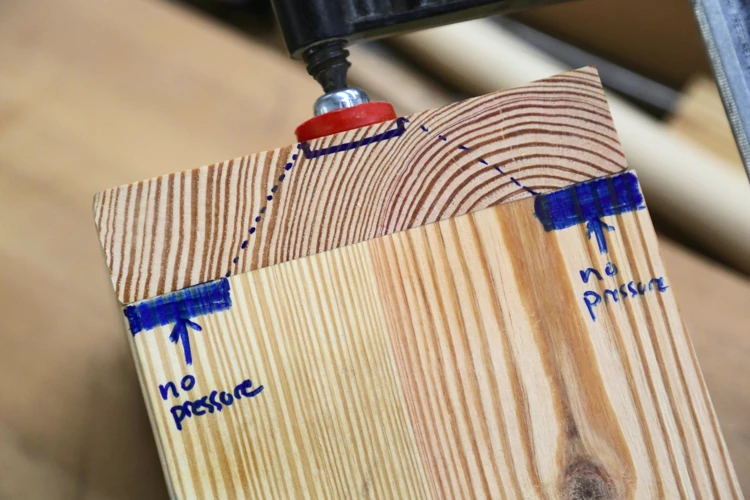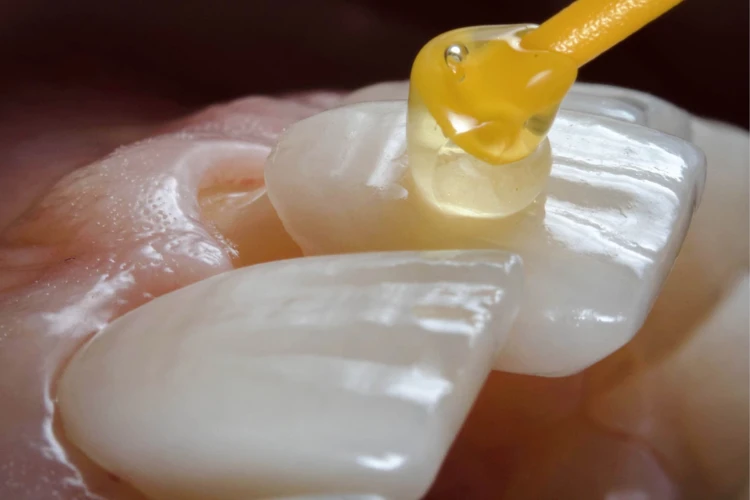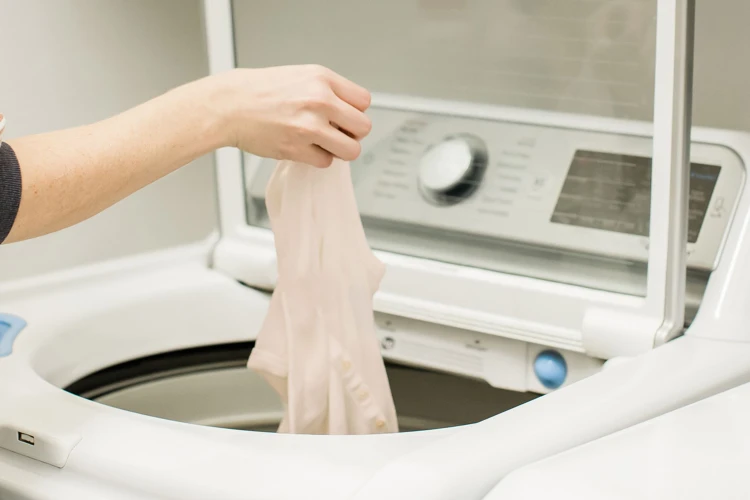You’re renovating your kitchen and have finally decided on a gorgeous quartz countertop. But now comes the tricky part: gluing it together. Whether you’re a seasoned DIYer or a novice looking to take on a new challenge, gluing a quartz countertop requires attention to detail and the right tools. In this guide, we’ll take you through a step-by-step process that will help you successfully glue your quartz countertops. From choosing the right glue to avoid common mistakes, this guide will provide you with the necessary know-how to complete the job like a pro. So, let’s dive in and get those countertops glued!
Step 1: Gather Necessary Tools and Materials
Before you can start gluing your quartz countertop, it’s important to gather all the necessary tools and materials. This step is crucial to ensure that you have everything you need on hand and don’t run into any delays or mistakes along the way. From choosing the right glue to selecting the proper clamping techniques, every detail counts when it comes to securing your countertop. In this article, we’ll guide you through the process step by step, so you can feel confident as you begin your countertop repair project.
Tools
Having the right tools is essential for successfully gluing a quartz countertop together. Here are the tools you’ll need:
- A caulk gun for applying the glue
- Clamps to hold the countertop pieces together while the glue dries
- A putty knife for smoothing out excess glue
- A razor blade or scraper for removing any glue that seeps out
- A measuring tape or ruler for measuring and marking the countertop
It’s important to have the right tools to ensure that the job can be done accurately and efficiently. If you’re missing any of these tools, don’t worry – they can easily be found at your local hardware store or home improvement center. Having a helper can make the job easier and more efficient.
If you’re unsure about which type of glue to use for your quartz countertop, check out our article on what acrylic glue is and its recommended uses.
Materials
For successful gluing of quartz countertops, various materials are required. Here is a list of materials that you will need to glue a quartz countertop:
| Materials | Description |
| Adhesive | The type of adhesive that needs to be used depends on the specific countertop material. For quartz, two-part epoxy or clear silicone adhesive works well. |
| Mineral Spirits | Mineral spirits are used to clean the surface of the countertop before applying the adhesive. |
| Masking Tape | Masking tape will help in holding the countertop pieces in place during the gluing process. |
| Clamps | Clamps are used to hold the countertop pieces together for a specified amount of time while the adhesive dries. |
| Plastic Spatula | A plastic spatula helps to remove excess adhesive after the countertop has been glued together. |
| Soft Cloth | A soft cloth will help to clean the surface of the countertop and remove any remaining adhesive. |
It’s important to note that using the wrong type of adhesive can lead to poor adhesion between the countertop pieces. If you’re unsure of the type of adhesive to use, you can consult with a professional or read the manufacturer’s instructions. It’s important to use the right amount of glue since too much or too little adhesive can cause various problems. For instance, too much adhesive can create a messy-looking joint, while too little can lead to weak adhesion.
In case you’re looking to glue two glass plates to a window, check out our guide on how to glue glass plates to a window. And if you’re interested in learning what resin glue is and its applications, you can check out our article on what is resin glue.
Step 2: Clean the Countertop Surface
Before beginning the process of gluing a quartz countertop, it is important to properly clean the surface. This ensures that the glue will properly adhere to the countertop and prevent any potential issues in the future. Cleaning the surface is a crucial step in the process that should not be overlooked or rushed.
To clean the countertop surface, start by removing any dust or debris with a clean cloth or towel. Next, use a pH-neutral cleaner specifically designed for quartz countertops and follow the manufacturer’s instructions. Avoid using harsh chemicals or abrasive cleaners as they can cause damage to the surface.
After cleaning the surface thoroughly, allow it to dry completely. Use a clean dry cloth to wipe away any excess moisture. Any moisture remaining on the surface can affect the adhesive properties of the glue and affect the final result.
Additionally, if there are any existing cracks or chips on the countertop surface, it is important to repair them before gluing the pieces together. This can be done through the use of a quartz repair kit or by contacting a professional to repair the surface.
By taking the time to properly clean the countertop surface, you can ensure that the glue will have a strong bond and provide a long-lasting solution. Remember, preparation is key when it comes to any DIY project.
If you’re interested in learning more about the adhesive properties of different types of glue, check out our article on PUR glue.
Step 3: Apply the Glue
As we move forward to the next step, it’s important to choose the right adhesive for your quartz countertop. Choosing the right glue is crucial in ensuring the countertop will not only stay in place but look seamless. If you’re not sure what type of glue to use for your quartz countertop, do some research beforehand, or consult an expert who can give you the right advice. The right adhesive can make all the difference in the final result. Additionally, once you have selected the adhesive, you should learn the proper application process for applying glue to your quartz countertop. This way, you can ensure that the adhesive will bond well to both surfaces, guaranteeing a sturdy countertop.
Choosing the Right Glue
When it comes to choosing the right glue for your quartz countertop, there are a few things you need to consider to ensure a successful job. Firstly, it’s important to choose a glue that is specifically designed for bonding quartz. Using the wrong type of glue can lead to weak joints and even damage to the countertop surface.
Two-part epoxy is the most commonly used glue for quartz countertops as it provides a strong and durable bond. It’s also resistant to water and heat, making it a great choice for use in the kitchen or bathroom. Another benefit of two-part epoxy is that it dries clear, leaving a seamless finish.
Silicone adhesive is another viable option and is best suited for smaller repairs. It’s important to note that silicone adhesive is not as strong as two-part epoxy and is not suitable for joining larger pieces of quartz together. However, it is very flexible, so it’s a great choice if you’re looking for a more pliable joint.
Construction adhesive can also be used for bonding quartz, but it’s important to choose one that is labeled as being suitable for use with non-porous surfaces. This type of adhesive sets quickly, but it’s not as strong as two-part epoxy and may not be suitable for large countertops.
It’s important to read the manufacturer’s instructions carefully before selecting a glue for your quartz countertop. The instructions will give you important information about how much glue to use and how long to let it dry. Additionally, some glues may require special handling or tools for application.
Remember, improperly bonding the pieces of a quartz countertop together can lead to cracking, chipping, or even breaking of the surface. So, it’s important to choose the right glue and follow the manufacturer’s instructions for the best results.
If you’re unsure which glue to use or how to properly bond your quartz countertop, it’s always a good idea to consult with a professional. They can provide you with the guidance and expertise needed to get the job done right.
Internal link: If you’re looking for information on how to glue metal to rubber, be sure to check out our article on how to glue metal to rubber.
Application Process
To ensure a proper and secure bond, the application process is crucial when gluing a quartz countertop. Before applying the glue, make sure that the surfaces are clean and dry. Wearing disposable gloves can prevent contamination from oil or dirt on your hands.
Below is a step-by-step guide for applying glue to a quartz countertop:
| Step | Instruction |
|---|---|
| Step 1 | Apply a thin layer of glue to one of the surfaces to be joined. |
| Step 2 | Use a notched trowel to spread the glue evenly over the surface. Make sure the notches on the trowel are the correct size for the thickness of the countertop pieces. A notched trowel helps ensure the glue is spread evenly and avoids excess glue buildup. |
| Step 3 | Apply glue to the second surface in the same way, using the same notched trowel. It’s important that both surfaces are covered with a thin and even layer of glue to create a strong bond. |
After applying the glue to both surfaces, carefully align the two pieces of the countertop. It’s important to align the pieces as accurately as possible to avoid any gaps or unevenness in the finished countertop. Once the pieces are properly aligned, gently press them together.
Finally, use a damp cloth to wipe away any excess glue that may have squeezed out from the joint. It’s important to clean up excess glue immediately to avoid it drying and becoming difficult to remove. After removing the excess glue, allow the joint to dry for the specified amount of time according to the glue manufacturer’s instructions before moving on to the clamping step.
To learn more about clamping techniques, please refer to the “How to Glue Cork to Ceramic Tile” article.
Step 4: Join the Countertop Pieces
After applying the glue, the next step is to join the countertop pieces together. This step requires precision and patience to ensure an accurate fit. It’s important to match the countertop pieces carefully and keep them level while joining.
One method is to use alignment pins to ensure the proper fit of the two pieces. If the countertop has a curved or irregular shape, then alignment tape is an alternative option.
Once the pieces are matched up correctly, you can slowly and carefully position them together. Make sure that the pieces butt up tightly against each other – any gaps will be noticeable after the glue dries. At this point, it’s crucial to make any necessary adjustments before the glue sets.
It’s also recommended to check the manufacturer’s recommendations to make sure the glue can be used on the type of surface you’re working with. Certain surfaces may require a different type of adhesive or application method – for example, if you’re gluing quartz cabochons, you might need to use a jewelry glue rather than the typical countertop adhesive.
If you’re unsure about whether you’re using the right type of glue or how to apply it properly, you may want to consider contacting a professional or seeking advice from an expert in the field. Additionally, if you’re looking for more information on gluing other types of materials, such as pot metal or how to glue a ring back together, there are many helpful articles available online offering step-by-step instructions.
Now that your countertop pieces are closely joined together, you can move on to the next step in the process.
Step 5: Clamp the Joints
When it comes to gluing a quartz countertop, one crucial step is to ensure that the joints are perfectly aligned. Once you have applied the glue, it’s time to clamp the joints to keep them together until the glue dries. Clamping is essential to ensure a strong and stable bond between the countertop pieces. In this step, we will discuss the proper clamping techniques for your quartz countertop project. But before we dive into that, let’s quickly review the necessary tools and materials required for the job.
Clamping Technique
Proper clamping is a vital part of gluing a quartz countertop. It secures the pieces in place while the adhesive dries. When clamping, it is important to have even pressure across the entirety of the joint to ensure a strong bond. Here’s a step-by-step guide on how to clamp a quartz countertop:
| Step | Instruction |
|---|---|
| Step 1 | Apply pressure to the center of the joint by adding a clamp in the middle. |
| Step 2 | Add clamps at both ends of the countertop. Make sure these are placed far enough from the joint to prevent the adhesive from squeezing out. |
| Step 3 | Insert additional clamps every 6-12 inches along the joint line. This will depend on the length of the countertop. |
| Step 4 | Check that all clamps are evenly distributed and apply pressure until glue begins to squeeze out of the joint. This ensures adhesive has covered the entire joint and that its excess is being removed. |
| Step 5 | Carefully clean off the excess glue while it is still wet, using a clean rag. Avoid touching the joint itself and just remove the excess glue. |
| Step 6 | Allow the glue to dry and cure completely before removing clamps. |
If the clamps are not evenly distributed, the joint may not hold correctly. Too much pressure in one area may cause the joint to buckle or warp. On the other hand, not enough pressure can cause gaps or voids in the bond. To ensure proper clamping, use a sufficient number of clamps, and monitor the joint throughout the drying process.
Remember to be careful when handling the quartz countertop during the clamping process. You do not want to move any of the pieces out of alignment and cause a misaligned joint. If you’re uncertain about your ability to clamp the countertop properly, consider hiring a professional.
To avoid making a mistake in the gluing process, follow the tips and guidelines outlined in this article. In case you need to glue similar types of materials, like cabochons, pot-metal or a ring, check our other articles on the topic: how to glue cabochons, how to glue pot metal, how to glue a ring back together. Also, if you’re wondering how long it takes for acrylic glue to dry, click here.
Step 6: Allow the Glue to Dry
After joining the countertop pieces and clamping them securely, it’s crucial to allow the glue to dry completely before removing the clamps. Rushing this step could compromise the structural integrity of the countertop and lead to a failed project.
How long should you wait for the glue to dry?
The amount of time required for the glue to set and dry depends on several factors, including the brand and type of glue used, the humidity levels in the room, and the ambient temperature. Typically, epoxy glues take anywhere from 24 to 48 hours to dry fully, while other types of adhesives may dry in as little as 30 minutes. It’s always best to check the manufacturer’s instructions on the product used and allow sufficient drying time to ensure a strong and secure bond.
What should you do while the glue is drying?
While waiting for the glue to dry, it’s important to avoid disturbing or moving the countertop pieces to ensure that the bond sets correctly. Ensure the clamps remain secure and in place until the glue has dried completely. It’s also essential to keep the room temperature and humidity levels consistent throughout the drying process to prevent any warping or uneven drying.
How can you tell if the glue is completely dry?
To check whether the glue has dried, examine the surface for any tackiness or soft spots. If the surface feels dry and hard, it’s a good indication that the glue has cured properly. However, it’s still best to wait for the maximum recommended drying time before removing the clamps and moving onto the next step.
Why is allowing the glue to dry important?
Drying time is critical to the success of the project. Not allowing the glue to dry adequately can cause the bond to weaken, leading to structural failure or damage. A poorly bonded countertop can result in cracks, chips, and other types of damage. It can be dangerous as it could compromise the integrity of the entire structure and cause injuries. Thus, taking the necessary time and care to let the glue dry completely is a crucial step in achieving a successful countertop bond.
Step 7: Check for Proper Adhesion
After allowing the glue to dry for the appropriate amount of time, it is vital to check for proper adhesion to ensure the longevity of your quartz countertop. This step will prevent any future issues that may arise from improper gluing.
Inspect the Joints: First, inspect the joints of your countertop to ensure they are flush and level. Check for any gaps between the joined pieces that could indicate inadequate gluing. If you find any such gaps, you may need to reapply glue and repeat the clamping process.
Check for Stability: After inspecting the joints, check for stability by gently pushing or tapping on the countertop surface. If you feel any movement, it means that the glue has not adhered correctly. In such a scenario, you may need to apply more glue and repeat the clamping process.
Test the Bond: The final step in checking for proper adhesion is to test the bond. Take a putty knife or scraper and gently scrape along the joint between the two pieces of quartz. If you can easily separate the pieces or if you notice any gaps between the joint, it indicates that the bond is weak and not strong enough. However, if you cannot separate the pieces or see any gaps, it is a good indication that the glue has successfully adhered.
Reapply Glue: If you encounter any issues during the adhesion check, particularly weak bonding, gaps, or movement between joined pieces, you may need to reapply glue to the area. In such cases, you should repeat the gluing process, clamping technique, and follow the proper drying times.
By following these steps and checking for proper adhesion, you can be confident that your quartz countertop is firmly and securely bonded for long-lasting durability.
Step 8: Remove Excess Glue and Polish Surface
After allowing the glue to dry, you’ll want to remove any excess glue that may have seeped out from the joints. This can be done using a putty knife to gently scrape away any visible glue. Be careful not to scratch the surface of the countertop, as quartz is quite durable but is not entirely resistant to scratches.
Once you’ve removed any excess glue, it’s time to polish the surface of the countertop. This will help to restore its shine and ensure that the joint between the two countertop pieces is as seamless as possible. To do this, you’ll need a soft cloth or sponge and a specialized quartz cleaner.
Gently apply the cleaner and begin polishing the surface of the countertop in circular motions. Keep in mind that quartz is sensitive to high pH and alkaline substances, so you should be careful not to use any abrasive or acidic cleaners. Use only cleaning solutions that are specifically designed for use on quartz surfaces.
Continue polishing the surface until you are satisfied with the results. If there are any remaining scratches or scuffs, you can try buffing them out with a diamond polishing pad. These pads are specifically designed for use on quartz surfaces and can effectively remove any minor blemishes that may have occurred during the gluing process.
Finally, wipe the surface of the countertop with a clean, dry cloth to remove any remaining polish or residue. Take a step back and admire your newly joined countertop, which should now look seamless and beautiful.
Tips for a Successful Job
When it comes to gluing a quartz countertop, attention to detail is key. In this complex process, even the smallest errors can have major consequences and lead to an unsuccessful job. To help you achieve the best results, we’ve compiled some crucial tips to keep in mind throughout every step of the process. Whether you’re a seasoned DIYer or just starting out, these tips will help ensure that everything goes smoothly and that your quartz countertop stays looking great for years to come. So, let’s dive in!
Tip 1: Work With a Helper
When gluing a quartz countertop, it can be quite challenging for one person to handle all the steps involved in the process. It is highly recommended to work with a helper. This can make the job easier, faster, and safer. Here are some reasons why having a helper is a great tip:
- Improved safety: When working with heavy materials such as quartz, there is a risk of injury if not handled properly. Having a helper can significantly reduce the chances of an accident happening during the job.
- Better precision: When gluing together two pieces of quartz, it is crucial to align them accurately. A helper can hold one piece in place while you glue the other, ensuring a perfect fit and avoiding any misalignment issues.
- Increase efficiency: Gluing a quartz countertop is a time-consuming and labor-intensive process. With two people, the job can be done faster, allowing for a more efficient use of time.
- Less stress: Assembling a quartz countertop can be stressful for one person, especially if they have limited experience in the field. With a helper, the job can be done with more ease and less stress.
It is highly recommended to have a helper when gluing a quartz countertop. The job will be easier, faster, and safer with two people involved.
Tip 2: Use the Right Amount of Glue
When it comes to gluing a quartz countertop, using the right amount of glue is crucial for a successful job. Applying too little glue may result in an unstable bond between the countertop pieces, while applying too much glue may cause an overflow that could damage the surface of the quartz. Here are some tips to ensure you’re using the right amount of glue:
- Read the manufacturer’s instructions: Before using any glue, read the instructions carefully. This will help you determine the appropriate amount of glue to apply based on the size of your countertop and the type of glue you’re using.
- Apply the glue evenly: Use a small putty knife to apply the glue in a thin layer over the surface of the countertop. Be sure to cover the entire surface evenly, while also avoiding an overflow.
- Avoid using too much glue: Remember, less is often more when it comes to glue. While it may be tempting to apply more glue for added stability, this can actually weaken the bond over time. Plus, excess glue can create a mess that can be difficult to clean up.
- Work with a partner: Having a partner can be helpful when it comes to using the right amount of glue. One person can apply the glue while the other person ensures an even distribution and helps avoid an overflow.
By following these tips, you can ensure that you’re using the right amount of glue for a strong and stable bond between your quartz countertop pieces. Remember to take your time and work carefully while applying the glue to avoid any errors that could compromise the integrity of the installation.
Tip 3: Use Proper Clamping Techniques
A crucial factor to ensure a sturdy and long-lasting joint is the clamping technique you apply while gluing your quartz countertop. Here are some proper clamping techniques to follow:
- Distribute clamps evenly: Make sure to distribute the clamps evenly along the seams to ensure that the joints close uniformly.
- Apply even pressure: Apply even pressure with the clamps to maintain the alignment of the countertop pieces. Uneven pressure can cause the pieces to shift, leading to an uneven seam.
- Use the right amount of pressure: Too much pressure can cause the glue to ooze out, and too little pressure will fail to close the joint. Use just enough pressure to hold the pieces together without causing any damage.
- Allow proper drying time: Be sure to allow the glue to dry fully before removing the clamps. Removing them too early can cause the joint to break, while leaving them on for too long can lead to sticking the clamps permanently to the countertop surface.
- Remove excess glue: Remove any excess glue that oozes out from the seam as it can harden and cause an unsightly finish. Use a damp cloth to wipe the glue away gently.
By knowing and applying these proper clamping techniques, you can ensure that your quartz countertop remains steady and secure for years to come.
Tip 4: Allow Sufficient Drying Time
Allowing sufficient drying time is crucial to ensure that the glue properly adheres and cures. Below are some tips to ensure that you allow enough time for the glue to dry:
- Refer to the label: Different types of glue require different amounts of drying time. Before beginning the gluing process, check the label on the glue container for specific instructions on drying times. Follow these instructions closely to prevent any issues.
- Extended drying time: If in doubt, it is best to allow for an extended drying time to give the adhesive ample time to set. Typically, it is best to leave the glue to dry for at least 24 hours before attempting to use the countertop.
- Avoid contact: Do not touch or put any weight on the countertop surface until the glue has completely dried. Avoid contact, or you may risk causing the glue joint to break or shift position.
- Avoid environmental factors: The drying time of certain types of glue is sensitive to external factors such as humidity, temperature, and sunlight. Be sure to work in a controlled environment where these external factors will not interfere with the glue’s drying process.
Taking adequate time to let the glue fully dry is critical to achieving a long-lasting bond. Rushing the drying process or improperly handling the glued countertop can lead to problems such as weak joints or gaps. Hence, waiting patiently and following all the instructions for drying time can ensure a successful and durable job.
Tip 5: Clean Up Excess Glue Immediately
Keeping the workspace clean is an essential part of any home improvement project, and this is particularly important when it comes to gluing a quartz countertop. As soon as you notice any excess or spillage of glue, clean it up immediately to avoid a sticky and messy situation. Here are some tips to help you clean up excess glue and maintain a clean workspace:
Tools
- Plastic scraper: Use a plastic scraper to remove excess glue from the surface of the countertop. Unlike metal scrapers, plastic scrapers are less likely to scratch or damage the surface of the quartz.
- Rag: Keep a clean rag or microfiber cloth handy to wipe away excess glue.
- Solvent: If the glue has dried, use a solvent such as acetone or rubbing alcohol to soften it and make it easier to remove.
If you fail to clean up excess glue immediately, it can leave a noticeable residue on your countertop. It can also interfere with the bonding and adhesion of the glue, making it less effective. To avoid this, use a plastic scraper to gently lift off any excess glue from the countertop surface. Be sure to work carefully and avoid scratching or damaging the quartz countertop.
In addition to using a scraper, you can also use a clean rag or a microfiber cloth to wipe away excess glue. Moisten the cloth with water or a solvent, and gently wipe away the glue from the countertop surface. Be sure to use a clean cloth and avoid spreading the glue around.
If the glue has had time to dry and has become hard, use a solvent to soften it and make it easier to remove. Acetone and rubbing alcohol are two common solvents that can help break down glue. Apply a small amount of the solvent to a clean rag or cloth, and gently rub the affected area. The solvent will soften the glue, making it easier to scrape or wipe away. Be sure to wear gloves and work in a well-ventilated area when using solvents.
By cleaning up excess glue immediately, you can avoid a mess and ensure that your quartz countertop looks its best. Keep these tips in mind when working with glue and maintain a clean workspace to achieve the best results.
Tip 6: Hire a Professional If Unsure
It’s completely understandable to feel unsure about gluing a quartz countertop together. If you feel like you don’t have enough experience or knowledge in this area, it’s best to hire a professional to do the job for you. There are several benefits to hiring a professional, including:
| Benefits of Hiring a Professional |
| 1. Experience and Knowledge |
| A professional has the experience and knowledge to properly glue a quartz countertop together. They are trained and have the necessary tools and materials to get the job done efficiently and effectively. |
| 2. Quality Workmanship |
| When you hire a professional, you can rest assured that the job will be done with quality workmanship. They have the necessary skills and expertise to glue your countertop together perfectly, leaving no room for error. |
| 3. Time-Saving |
| Gluing a countertop together can be a time-consuming process, especially if you don’t have the necessary experience. By hiring a professional, you’ll save yourself time and energy, allowing you to focus on other important tasks. |
| 4. Cost-Effective |
| While it may seem like hiring a professional is more expensive upfront, it can actually be more cost-effective in the long run. If you make a mistake while gluing your countertop together, you may end up having to start over or even replacing the entire countertop. |
If you are unsure about your ability to glue a quartz countertop together, don’t hesitate to reach out to a professional. It’s better to be safe than sorry and to have the job done right the first time.
Common Mistakes to Avoid
As with any DIY project, mistakes can happen during the process of gluing a quartz countertop. It’s important to be aware of the common mistakes that can occur and take steps to avoid them. By doing so, you can ensure that the outcome of your project is successful and the countertop is securely glued in place for years to come. In this section, we will highlight some of the most common mistakes to avoid during the quartz countertop gluing process. By being aware of these mistakes, you can take steps to prevent them from occurring and ensure a smooth and successful application.
Mistake 1: Using the Wrong Type of Glue
Mistake 1: Using the Wrong Type of Glue
One of the most common mistakes when gluing quartz countertops is using the wrong type of glue. There are various types of adhesives available, each designed for specific types of materials. Using the wrong type of glue can result in weak bonds that may break or fall apart over time.
To avoid this mistake, it is important to choose the right glue for your quartz countertop. The table below highlights some popular glues and their corresponding uses:
| Glue Type | Intended Use |
|---|---|
| Epoxy | Recommended for bonding quartz countertops. Provides a strong and durable bond, and can withstand exposure to heat and moisture. |
| Silicone | Generally not recommended for bonding quartz countertops as it may not provide a strong enough bond. However, it can be used for minor repairs or sealing. |
| Construction Adhesive | Not recommended for bonding quartz countertops as it may not provide a strong enough bond. Intended for use with porous materials such as wood or concrete. |
Before starting your project, it is important to do your research and determine the type of glue that is best suited for your quartz countertop. Using the wrong glue can result in a weak bond that may break or come apart over time, leading to potential damage to your countertop and costly repairs.
Mistake 2: Not Cleaning the Surface Properly
One of the most common mistakes people make when gluing quartz countertops is not cleaning the surface properly. This error can compromise the adhesive’s effectiveness, causing the countertop to come apart.
Why is cleaning the surface important?
Before applying glue, the surface must be free of any dirt, dust, or debris that might interfere with the bond. Quartz countertops are non-porous, meaning they do not absorb liquid. This trait makes them easy to clean with soap and water or an appropriate cleaner. Once the surface is clean, it should be wiped dry with a cloth.
What should you use to clean the surface?
It is essential to use the right cleaning product when cleaning a quartz countertop. Abrasive cleaners and scouring pads should be avoided as they can scratch the surface or dull its finish. Instead, use a gentle cleaner specifically formulated for quartz surfaces. The manufacturer may recommend a brand of cleaner that works best on their product.
How to clean the surface properly?
To clean the surface correctly, use the following steps:
| Step | Description |
|---|---|
| Step 1 | Remove any debris or food particles from the surface with a soft cloth or sponge. |
| Step 2 | Apply the quartz cleaner according to the manufacturer’s instructions, and scrub gently with a non-abrasive sponge or soft cloth. |
| Step 3 | Rinse the surface with clean water and wipe it dry with a cloth or paper towel. |
| Step 4 | If there are any tough stains or residues left, repeat the process until the surface is clean. |
By following the steps above, you will ensure that the surface is clean and free of any dirt, dust, or debris. This will help the glue form a strong bond and create a lasting joint between the countertop pieces. Avoiding this mistake will increase the likelihood of a successful job and maximize the longevity of the countertop.
Mistake 3: Not Applying Enough Glue
One of the biggest mistakes you can make when gluing a quartz countertop is not applying enough glue. When you don’t use enough glue, the joint between the two pieces of countertop may not be strong enough to withstand regular use and may come apart over time. Proper application of glue is critical to ensure a strong and durable bond between the countertop pieces.
To avoid this mistake, it’s essential to follow the manufacturer’s instructions when it comes to the amount of glue needed for your specific countertop. Using too much glue can also be problematic, so it’s important to strike the right balance.
To help you get it right, here are some tips to keep in mind:
| Tip | Description |
|---|---|
| Read the instructions on the glue | Before beginning your project, be sure to read the instructions that come with the glue. Pay attention to the recommended amount of glue to use for your specific quartz countertop and be sure to follow it closely. |
| Apply the glue in a zigzag pattern | To ensure that the glue is evenly distributed, apply it in a zigzag pattern. This will help to prevent any gaps in the adhesive and ensure that the entire joint is properly covered. |
| Use a putty knife to spread the glue | After applying the glue in a zigzag pattern, use a putty knife to spread it out evenly across the joint. This will help to ensure that the glue covers the entire joint and that there are no gaps. |
| Check that you have enough glue | Before clamping the joints together, double-check to make sure that you have used enough glue. If you’re not sure, add a little bit more to be on the safe side. |
By following these tips and ensuring that you use enough glue for your specific quartz countertop, you can avoid the mistake of not applying enough glue and ensure a strong and durable bond between the countertop pieces.
Mistake 4: Not Clamping the Joints Correctly
When it comes to gluing a quartz countertop, not clamping the joints correctly can be a costly mistake. It is essential to ensure that the adhesive can dry correctly and that the joined pieces are securely held in place. Improper clamping can result in uneven seams, a wobbly countertop, or even cause the joint to break apart over time.
Here are some common mistakes to avoid when clamping joints:
| Mistake | Consequence |
|---|---|
| Not Using Enough Clamps | If not enough clamps are used, the adhesive may not hold correctly, resulting in an uneven seam or a wobbly countertop. It is recommended to use one clamp every six inches along the joint. |
| Using Improperly Sized Clamps | Using clamps that are too small or too large can create uneven pressure and possibly break the joint apart. It’s essential to use clamps that are the correct size for the job. |
| Not Tightening the Clamps Enough | If the clamps are not tightened enough, the pieces may shift, resulting in an uneven seam or a wobbly countertop. It’s essential to tighten the clamps just enough to hold the pieces together firmly. |
| Removing Clamps Too Soon | Removing the clamps too soon can cause the adhesive to shift or dry unevenly, leading to an uneven seam or a weak joint. It’s crucial to leave the clamps in place for the recommended drying time. |
Remember that clamping the joints correctly is vital for ensuring a successful and long-lasting quartz countertop. By avoiding these common mistakes and taking the time to clamp the joints properly, you can achieve a beautiful and durable countertop that will last for years to come.
Mistake 5: Rushing the Job
One of the most common mistakes people make when gluing quartz countertops is rushing the job. It’s understandable that you may want to complete the task as quickly as possible, but cutting corners can lead to disastrous results. Here are some things to avoid if you want to prevent this mistake:
- Not Allowing Sufficient Drying Time: Rushing to use the countertop before the glue has fully dried can result in weak joints and even cause the pieces to shift or become misaligned.
- Skipping Cleaning Steps: Failing to clean the surface thoroughly before applying the glue can prevent proper adhesion and cause the countertop to come apart over time.
- Using Too Little Glue: Not using enough glue can create weak joints that may not withstand the weight or pressure put on the countertop, resulting in it falling apart.
- Forgetting to Clamp Correctly: Clamping the pieces together is essential for a strong bond, but rushing the clamping process or not doing it correctly can cause the pieces to shift or prevent proper adhesion.
- Not Polishing the Surface: Neglecting to polish the surface after the glue has dried can result in rough or uneven spots, impacting the countertop’s appearance and durability over time.
Remember, taking your time and following each step carefully is essential for a successful gluing job. Rushing may save you time in the short term, but it will ultimately result in a failure that will require more time, effort, and money to fix in the long run.
Conclusion
In conclusion, gluing a quartz countertop may seem like a daunting task, but it is a fairly straightforward process that can be accomplished with proper preparation, the right tools and materials, and careful attention to detail. By following the step-by-step guide outlined in this article, you should be able to successfully glue your countertop and achieve a seamless, professional-looking finish.
Remember to take the proper precautions when handling the potentially hazardous materials involved in this process, and never skimp on safety equipment like gloves and masks. It’s also important to follow manufacturer instructions for any adhesives or tools you use, and to seek out professional help if you feel unsure about any step of the process.
By avoiding common mistakes like using the wrong type of glue, rushing the job, or failing to apply enough adhesive, you can ensure that your countertop looks and functions flawlessly for years to come.
So take your time, be patient, and don’t be afraid to ask for help when you need it. With a little effort and attention to detail, you can create a beautiful, durable, and functional quartz countertop that will be the envy of all your friends and family. Good luck, and happy gluing!
Frequently Asked Questions
What is the best glue for quartz countertops?
There are several options for gluing quartz countertops, but epoxy-based adhesives are highly recommended due to their strength and durability.
Can I glue a broken quartz countertop?
Yes, you can glue a broken quartz countertop with the right adhesive and technique. It’s best to work with a professional for a seamless repair.
How do I clean the surface before gluing?
Before applying glue, make sure to remove any debris, grease, or residue from the surface using a household cleaner and a soft cloth. Allow the surface to dry completely before gluing.
Do I need to clamp the joints when gluing quartz countertops?
Yes, clamping the joints is essential to ensure a tight and secure bond between the pieces. Proper clamping technique will prevent shifting and ensure a seamless finish.
How long does it take for the glue to dry?
Drying times will vary depending on the type of adhesive used and the temperature and humidity in the environment. In general, allow 24-48 hours for complete drying and curing.
Can I use regular household glue for quartz countertops?
No, household glue is not strong enough for the weight and durability of quartz countertops. It’s important to use a specialized adhesive designed for stone surfaces.
What should I do if excess glue dries on the surface?
If excess glue dries on the surface, gently sand the area with a fine-grit sandpaper. Avoid using sharp objects or abrasive cleaners that can damage the surface.
How do I know if the adhesive has bonded properly?
You can test the adhesion of the glue by gently tapping the joint with a rubber mallet. If it feels secure and there is no movement or shifting, then the bond should be strong enough.
What safety precautions should I take when gluing quartz countertops?
Be sure to wear protective gloves and eye goggles when handling adhesives. Work in a well-ventilated area and avoid inhaling fumes or vapors.
Is it easy to do a DIY glue job for quartz countertops?
While DIY gluing is possible, it’s highly recommended to work with a professional for a seamless and long-lasting finish. A skilled professional can also ensure that the job is done safely and efficiently.
